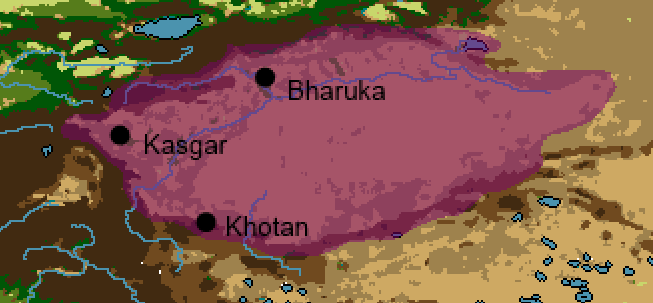Contrasting with their patriarchal society, most important Southern Iberian deities were goddesses. At the head, there was Amalur, "Mother Earth", literally, than, although in early stages it was more a primordial force than a true Goddess, in classical times it would have adquired anthropomorphic features, and was represented as a mature woman in art and literature.
Earth was seen as the receptacle were all thing existed, both dead and living. She created the twin sisters Ilazki and Eguzki, that is, Moon and Sun. Another daughter of her was Mari, or "The Lady", as she was known, the Goddess of Nature, and Climate, as she was able to turn into stormclouds, fire, and other nature phenomenons.
Both Mari and Amalur lived underground, in vast nets of palaces and houses, full of all kind of treasures, and that was the origin of the tradition of leaving a small coin or beautiful coin each time a Betisman entered into a cave, as a tribute for the Godesses, because as everybody knows, each tunnel, cave and grotto ultimately leads to the realm of Mari and Amalur. In these same palaces, dead people slept and lived, waiting their time for reincarnation.
In a "lower" level, at least at a mythological sense, we had other kind of magical and semidivine creatures. First among them were the "Basajaun", or wild lords, naked, tall, bearded men which lived in woods and forest, protecting them and helping shepherds and lost travellers, as they were a kind people. According to legend, they teached to men the art of agriculture, and metalworking, and raised the human from the savage state in which they were. Next, there were the Lamias, beautiful, magical women, which lived in caves and huts in the deepest place of the forest, which liked to tease men with her beauty and treasure to devoure them, and women to become their slaves. Although, if you stole their golden comb, they would be forced to obey you. Their husbands were the Mardeak, bestial, ugly men, which fiercely protected the Lamia and her treasures if anything threatened them. A kind of Lamia was the Amilamia, or "Lamia friend", which were good Lamias which helped men with their power, for some kind of payment. Even smaller, would be the smallfolk, fey, and gnomes, most famously the Gorri-Txiki, a kind of domestic gnome which both helped and teased the family.
Finally, as this is not the place to expand upon the Betis Creatures, there was the Gaueko, the Nightlord. A dark, violent, intelligent dog, which was supposed to rule the world at night, and to whom people made sacrifices and offered tributes, fearing his rage, although he was no god. He is even the matter of one of the most famous Betis saying: "Gaua gauekoentzat eta eguna egunekoentzat". That is: The day belong to the ones of the day, but the night belongs to the Gaueko"
Earth was seen as the receptacle were all thing existed, both dead and living. She created the twin sisters Ilazki and Eguzki, that is, Moon and Sun. Another daughter of her was Mari, or "The Lady", as she was known, the Goddess of Nature, and Climate, as she was able to turn into stormclouds, fire, and other nature phenomenons.
Both Mari and Amalur lived underground, in vast nets of palaces and houses, full of all kind of treasures, and that was the origin of the tradition of leaving a small coin or beautiful coin each time a Betisman entered into a cave, as a tribute for the Godesses, because as everybody knows, each tunnel, cave and grotto ultimately leads to the realm of Mari and Amalur. In these same palaces, dead people slept and lived, waiting their time for reincarnation.
In a "lower" level, at least at a mythological sense, we had other kind of magical and semidivine creatures. First among them were the "Basajaun", or wild lords, naked, tall, bearded men which lived in woods and forest, protecting them and helping shepherds and lost travellers, as they were a kind people. According to legend, they teached to men the art of agriculture, and metalworking, and raised the human from the savage state in which they were. Next, there were the Lamias, beautiful, magical women, which lived in caves and huts in the deepest place of the forest, which liked to tease men with her beauty and treasure to devoure them, and women to become their slaves. Although, if you stole their golden comb, they would be forced to obey you. Their husbands were the Mardeak, bestial, ugly men, which fiercely protected the Lamia and her treasures if anything threatened them. A kind of Lamia was the Amilamia, or "Lamia friend", which were good Lamias which helped men with their power, for some kind of payment. Even smaller, would be the smallfolk, fey, and gnomes, most famously the Gorri-Txiki, a kind of domestic gnome which both helped and teased the family.
Finally, as this is not the place to expand upon the Betis Creatures, there was the Gaueko, the Nightlord. A dark, violent, intelligent dog, which was supposed to rule the world at night, and to whom people made sacrifices and offered tributes, fearing his rage, although he was no god. He is even the matter of one of the most famous Betis saying: "Gaua gauekoentzat eta eguna egunekoentzat". That is: The day belong to the ones of the day, but the night belongs to the Gaueko"






